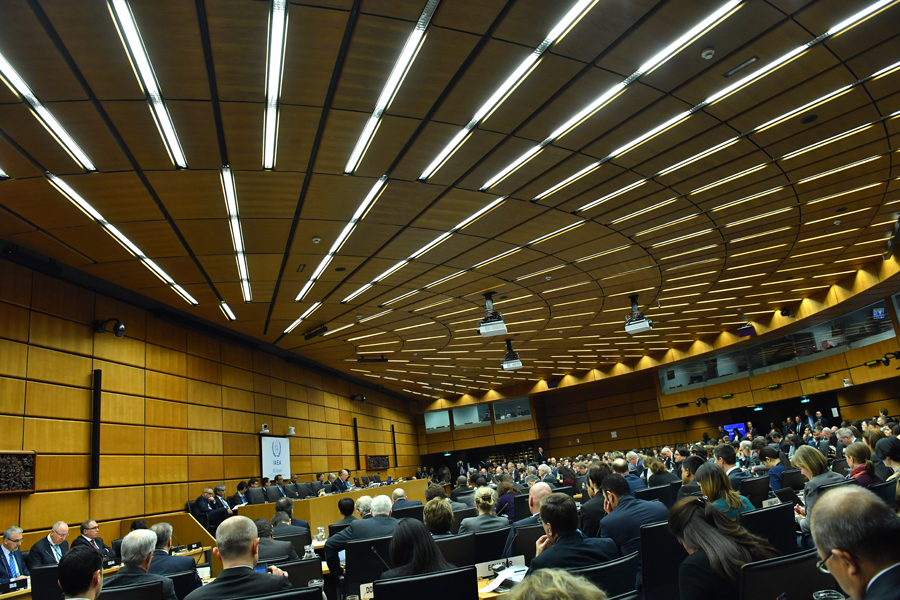“For 50 years, the Arms Control Association has educated citizens around the world to help create broad support for U.S.-led arms control and nonproliferation achievements.”
IAEA Provides More Detail on Iran
April 2017
The International Atomic Energy Agency (IAEA) provided greater detail about Iran’s nuclear activities in its most recent report, drawing praise from the United States and criticism from Iran.
The IAEA is tasked with monitoring Iran’s nuclear activities under the July 2015 nuclear deal between Iran and the P5+1 countries (China, France, Germany, Russia, the United Kingdom, and the United States) and reporting quarterly to the agency’s Board of Governors. The agency issued its most recent report on Feb. 24 ahead of the March 6-10 quarterly board meeting.
 For the first time since the agreement was fully implemented in January 2016, the IAEA reported on the size of Iran’s stockpile of uranium enriched to 3.67 percent. The IAEA said Iran had 101.7 kilograms in several different forms. Under the deal, Iran can keep up to 300 kilograms of uranium enriched to 3.67 percent, a level suitable for fueling nuclear power reactors but far below the enrichment level necessary to fuel a nuclear weapon.
For the first time since the agreement was fully implemented in January 2016, the IAEA reported on the size of Iran’s stockpile of uranium enriched to 3.67 percent. The IAEA said Iran had 101.7 kilograms in several different forms. Under the deal, Iran can keep up to 300 kilograms of uranium enriched to 3.67 percent, a level suitable for fueling nuclear power reactors but far below the enrichment level necessary to fuel a nuclear weapon.
IAEA Director-General Yukiya Amano said that the report provides more information on Iran’s stockpile of low-enriched uranium because of “clarifications” agreed by the Joint Commission. The commission, comprised of representatives from the P5+1 countries, Iran, and the European Union, oversees implementation of the deal and resolves technical and compliance issues.
In December 2016 and January 2017, the commission publicly released decisions it had made over the past year. The January document included an agreement on how to account for enriched uranium that remained in process lines at a plant used by Iran to convert uranium gas into powder. According to the document, Iran could take certain steps under IAEA verification to render the material “unrecoverable,” so it does not count against the 300 kilogram stockpile limit.
Andrew Schofer, a senior official at the U.S. Mission to the International Organizations in Vienna, said in a statement during the IAEA board meeting that the United States welcomes the “inclusion of the additional level of detail, and expects it will continue in the future.” Iran’s ambassador to the IAEA, Reza Najafi, disagreed and requested that the IAEA produce future reports that are “as concise as possible.” He said that Tehran opposes the “inclusion of confidential safeguard information under the pretext of transparency.”
The report also noted that Iran’s stockpile of heavy water was 124 metric tons, less than the limit of 130 metric tons established by the deal. Iran is permitted to produce heavy water, which is used to moderate certain types of reactors such as the IR-40 reactor Iran is constructing at Arak, and can sell any excess material on the open market. The quantity is capped based on an assessment of Iran’s needs.
The previous IAEA report, issued in November 2016, said that Iran slightly exceeded the limit and possessed 130.1 metric tons. The Feb. 24 report said that the IAEA verified that 11 metric tons were shipped out of Iran on Nov. 19. The agency verified Dec. 6 that all of the heavy water reached its destination and is in storage in another country.
Najafi contested the necessity of this step during the board meeting and said that nothing requires Iran to ship out heavy water in excess of 130 metric tons if Tehran has not found a buyer. Schofer responded by saying that the deal clearly states that Iran cannot accumulate heavy water in excess of 130 metric tons.
The IAEA report also said that Iran began feeding natural uranium gas into a single IR-8 centrifuge Jan. 21. The IAEA said in its report that this activity is within the limits defined by the deal, which allows testing on a single IR-8 machine in a way that precludes Iran from withdrawing enriched or depleted uranium and under agency monitoring.
Iran is only permitted to produce uranium enriched to 3.67 percent using 5,060 first-generation IR-1 centrifuges at its Natanz facility. The IAEA report said that Iran is abiding by that restriction. Iran’s state-owned Press TV cited a spokesman for the Atomic Energy Organization of Iran on Feb. 14 saying that the new domestically manufactured IR-8 centrifuge is 20 times more productive than the IR-1. Iran anticipates mass producing IR-8s as international restrictions are eased starting eight years after the implementation of the nuclear deal, said spokesman Behrouz Kamalvandi.
The Feb. 24 IAEA report said that Iran continues to allow inspectors access to nuclear facilities and sites in Iran, but did not specify if any of the locations inspected are facilities other than Tehran’s declared nuclear sites.
